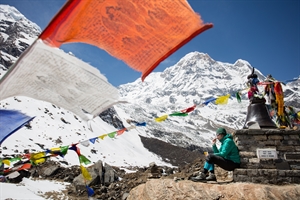If you’re scaling Kilimanjaro, or trekking to Everest Basecamp, you’ll be spending time above 7,900 feet. Other destinations at altitude are Bogota in Columbia, Quito in Ecuador, Lhasa Tibet and La Paz, Bolivia. You need to be aware of altitude sickness, also known as acute mountain sickness (AMS), to stay safe in these destinations.
What is altitude sickness?
The pressure is lower at altitude than it is at sea level, and this means that it is harder for your body to absorb oxygen from the air. The body needs to take three to five days to adapt, or acclimatise, to conditions at altitude. The process can be helped by ascending slowly (1,000 feet a day) with a rest day every three to four days, and by eating a high calorie diet and by keeping your fluids up. There is a medication available, acetazolamide (Diamox), which some people find effective.
If you fail to acclimatise, you will be susceptible to acute mountain sickness. Flying straight into a place above 7,900 feet puts you at risk of altitude sickness.
Symptoms of acute mountain sickness occur within the first 36 hours of arrival, and may feel a bit like a hangover:
- breathlessness
- dizziness
- fatigue
- headache
- interrupted sleep
- nausea or vomiting and loss of appetite
Is altitude sickness dangerous?
If you continue to climb higher, acute mountain sickness may become very serious indeed. It can progress to one of two lethal conditions, high altitude cerebral oedema (HACE), which affects the brain, and high altitude pulmonary oedema (HAPE), which affects the lungs. At altitude, symptoms such as confusion and unsteadiness and breathlessness at rest should be considered medical emergencies. A person with suspected HACE or HAPE may not be thinking clearly, and needs to be carried to a lower altitude immediately.
I think I have altitude sickness
Do not ignore the symptoms of AMS. Mild altitude sickness will pass if you descend or acclimatise at the same altitude. Do not go higher. Let your travel companions know you how you are feeling. Rest, take painkillers for the headache and keep your fluids up. If your symptoms do not improve after a day, descend by 500-1,000m. Get medical help if you do not improve after this.
Other things to think about before travelling to a high altitude
Will it affect your medical condition?
If you have a long-term condition, for example diabetes, sickle cell disease or asthma, speak with your usual healthcare provider about your travel plans. You may also wish to talk it over during your travel health appointment with the specialist nurses at one of our clinics.
Are you insured?
Medical evacuation can be extremely difficult and expensive at altitude. Check your insurance coverage before you head into the mountains.
UV radiation at altitude
At high altitude you will be more exposed to UV radiation, which means you need to take extra care to avoid sunburn. Use a top-quality sunscreen that has an SPF of at least 15 and protects against UVA, UVB and UVC and put it on regularly. Apply sunblock to your lips, ears and nose, and protect eyes with wrap-around sunglasses.


Book Online